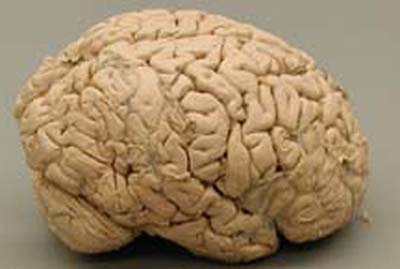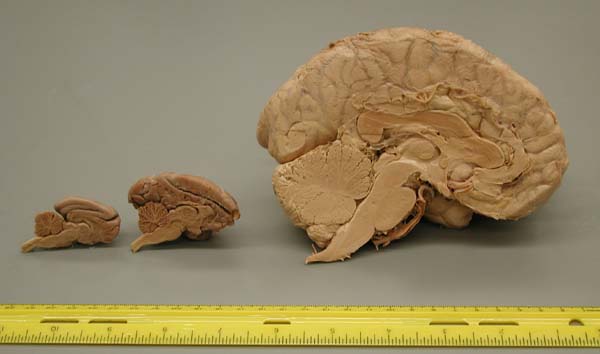Remote Ready Biology Learning Activities has 50 remote-ready activities, which work for either your classroom or remote teaching.
Serendip is an independent site partnering with faculty at multiple colleges and universities around the world. Happy exploring!
 |
The Bipartite Brain
|
 |
 |
 http://www9.biostr.washington.edu/DA-ATLASES/Neuroanatomy/gifs/Forebrain/Coronal%20Slabs/f60eb.gif |  |
 |
To a reasonable first approximation, different brains and different regions of a given brain are distinguished by the pattern of connectivity among neurons each of which can usefully be regarded as a unit that collects information, processes it, and transmits it. The human brain consists of a frog brain surrounded by a large amount of neocortex. Massive compact bundles of axons distinctively link the neocortex to the rest of the nervous system in humans. Sensory and motor neurons occur only in parts of the nervous system other than the neocortex. |
 |
 http://www.sleephomepages.org/sleepsyllabus/a.html |
A global measure of patterns of activity in the neocortex correlates closely with the presence or absence of internal experience. Correlative observations. Quadraplegics respond to inputs to arms/legs but report no associated experience. They do report internal experiences associated with inputs to face/head. Sleep walking is the converse of dreaming. Activity with no internal experience. EEG is, consistent with the above, synchronized. |
 |
|
Blindsight
Cortical "paralysis" Agnosias, including particularly hemispatial neglect |
Damage to the neocortex may abolish internal experiences associated with inputs without loss of adaptive behavior, may abolish willed outputs without loss of outputs. Losses are frequently not "noticed", ie there is a completeness/coherence of what is experienced. More generally, internal experiences do not bear a one to one relation to input. Correlative observations. Quadraplegics are unable to will movements of their arms and legs. They can will movments of head/face/neck and can experience the will to move arms and legs. Amputees may have experiences of sensation and location of missing limbs. Blindspot, visual ambiguity more generally (see also "Human brain activity during spontaneously reversing perception of ambiguous figures") |
 |
|
Seven plus or minus two
?????? |
The lower and upper modules differ in information processing "style". Among other differences, the lower is capable of dealing productively with large numbers of variables with poorly specified relations among them and is capable of doing large numbers of tasks simultaneously while the upper the upper works better in terms of particular tasks which it tends to try and deal with in terms of smaller numbers of variables with well-defined and preferably uni-directional relations among them. The two modules have differing strengths and weaknesses. The upper module is distinctive in having the ability to notice and extend patterns and, using these, to conceive organizations other than those that can be derived from patterns of activity available to the lower module. The lower module consists of a number of specialized circuits that are organized in relation to and function entirely based on "what works". The brain consists of an "idealist" sitting on the back of a "pragmatist". Correlative observations. Semi-autonomy of most neural systems Metonyms and metaphors, projective testing, slips of the tongue Importance of not "thinking" when engaged in skilled physical activity Usefulness of "emotion" and "intuition" (Damasio) Usefulness of not always acting out of "emotion", "intuition" Intuitive physics (M. McCloskey, Sci Am, 1983), intuitive mathematics |
 |
|
The locus, reality, and significance of "story telling" ... Idealism as the resolution of brain/thought conflict (for Rob) Story as conflict resolver, causal agent Story as distinct from experiences, coherence-demanding, inertial, resistant to change, contributor to conflict Story as creator of new worlds, and of the distinction between ontology and epistemology, between form and matter, etc etc etc
|
The upper module creates "stories", ie coherent abstractions reflecting the less coherent inputs provided from the lower module. These stories are patterns of activity across the neocortex but are not uniquely determined by the activity of and/or activity of the lower module. They are, in addition, of causal significance for the activity of the lower module and hence also for the output activity of the system as a whole. Among the distinctive characteristics of "stories" is a greater "coherence" than exists in the lower module, some resistance to alteration, and a capacity to conceive counterfactuals which in turn may bring into existence new material entities in the outside world. Correlative observations. |

|
|
Avoiding solipsism - similarities in stories suggest the existence of some commonality in input, hence the existence of a relatively stable "outside" world, or "reality" (similarities in internal organization due to gene similarities may also contribute) - both the outside world and reality are "stories" to account for similarities in stories
Interpersonal phenomena - One frequently has the impression that there are several distinct ways to communicate/interact, including pure and direct transmission of ideas/stories. In fact, all interaction occurs via sensory and motor neurons and via the lower module. However, there are in humans particularly some relatively direct pathways from input to story teller and story teller to output that would seem to reflect a specialization for story-sharing in a more direct mode and for exchange between story teller of one person and lower module of another. |

What is the neural equivilent of story "coherence"? of story "inertia"?
|
|
added following 25 January discussion A "good" scientific story
Local consideration:
The present case ...
Interesting issue re "science", "falsifiability", and, still deeper, the accessibility/legitimacy of story. Has to do with what people will/won't take as justification ("evidence") for putting building blocks in particular configurations. And hence with constraints (unconsciously created) on what stories can be built/heard/tested qua stories. Is, in some sense, an insistence on "continuity" of story both in space and in time. Encourages stories to be changed in time in small steps and by using local criteria. A non-catastrophic story telling style (neither big change nor external factors). |
| Brain and Behavior Forum | Brain and Behavior | Serendip Home | |